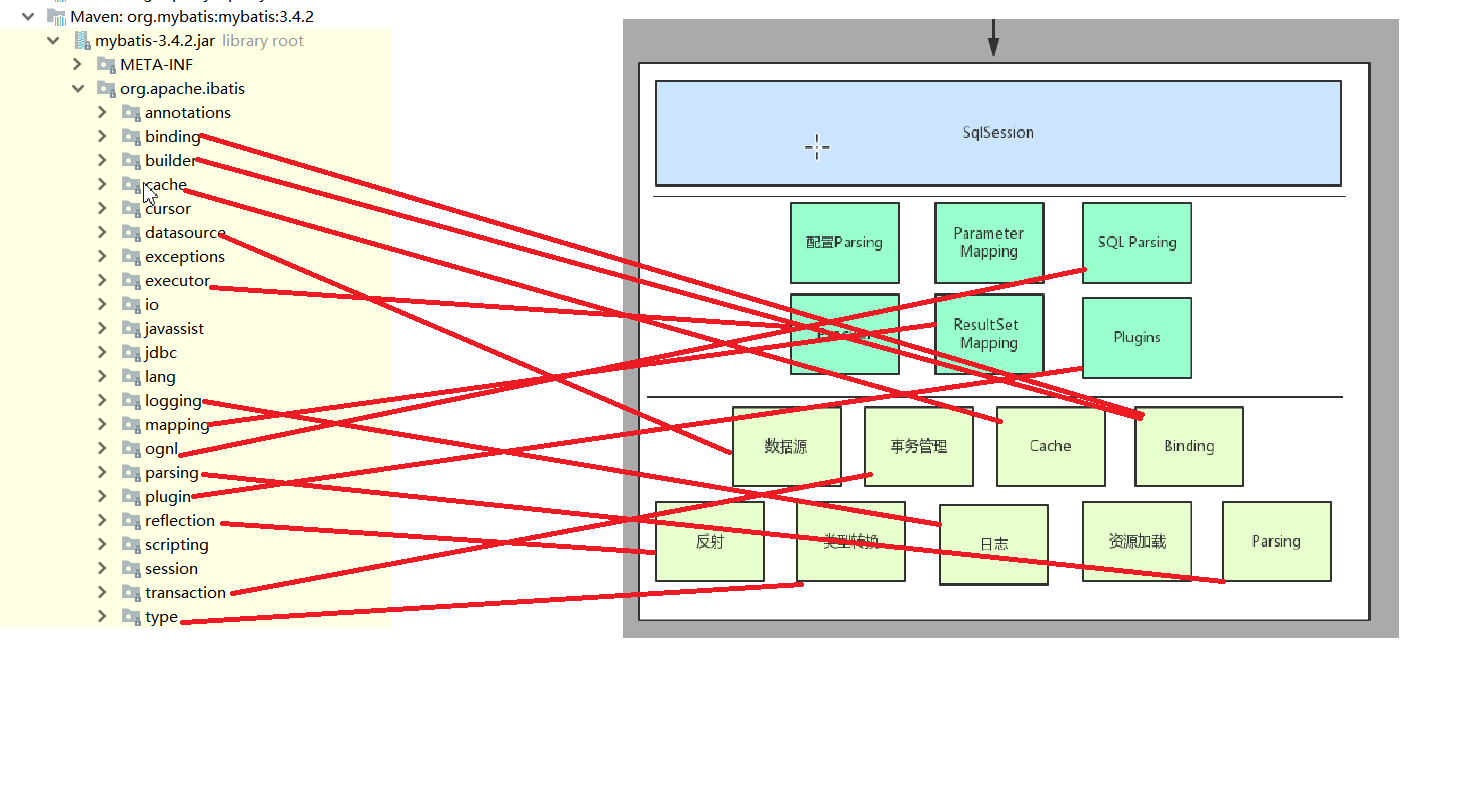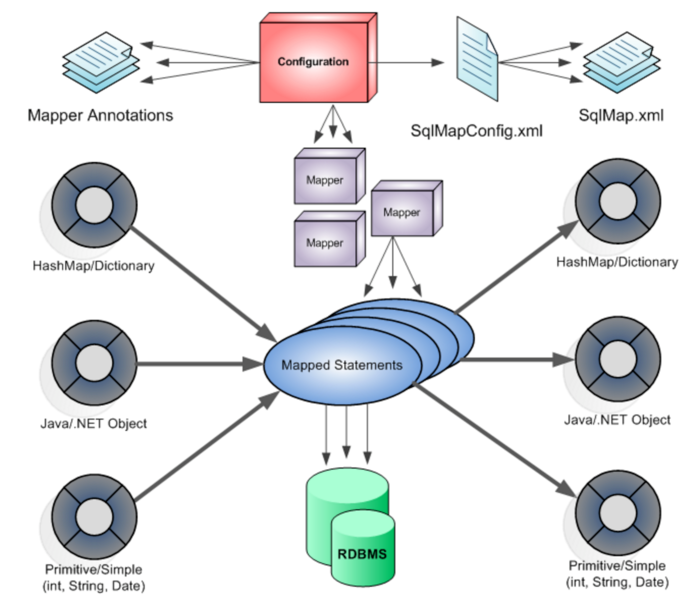一,总览
1.1,图解一

1.2,图解二

MyBatis应用程序根据XML配置文件创建SqlSessionFactory,SqlSessionFactory在根据配置,配置来源于两个地方,一处是配置文件,一处是Java代码的注解,获取一个SqlSession。SqlSession包含了执行sql所需要的所有方法,可以通过SqlSession实例直接运行映射的sql语句,完成对数据的增删改查和事务提交等,用完之后关闭SqlSession。
二,源码解析

public static SqlSession getSqlSession() throws FileNotFoundException { //配置文件 InputStream configFile = new FileInputStream( "D:\\data\\workspace\\idea-workspace\\gupaoedu-mybatis-master-e4043a9342d1936369eeb63e79ea4d0250d447c0\\src\\main\\java\\com\\gupaoedu\\mybatis\\demo\\mybatis-config.xml"); SqlSessionFactory sqlSessionFactory = new SqlSessionFactoryBuilder().build(configFile); //加载配置文件得到SqlSessionFactory return sqlSessionFactory.openSession(); } public static void main(String[] args) throws FileNotFoundException { TestMapper testMapper = getSqlSession().getMapper(TestMapper.class); Test test = testMapper.selectByPrimaryKey(1); }
InputStream configFile = new FileInputStream(
"D:\\data\\workspace\\idea-workspace\\gupaoedu-mybatis-master-e4043a9342d1936369eeb63e79ea4d0250d447c0\\src\\main\\java\\com\\gupaoedu\\mybatis\\demo\\mybatis-config.xml");
SqlSessionFactory sqlSessionFactory = new SqlSessionFactoryBuilder().build(configFile);
//加载配置文件得到SqlSessionFactory
return sqlSessionFactory.openSession();
这几步就不看源码了,加载xml文件然后生成sqlseesion的
2.1,TestMapper testMapper = getSqlSession().getMapper(TestMapper.class);
我们来看一下这一步源码是怎么跑的,这一步最主要的就是生成一个动态代理,那么它是怎么生成的呢?
org.apache.ibatis.session.defaults.DefaultSqlSession
@Override public <T> T getMapper(Class<T> type) { return configuration.<T>getMapper(type, this); }
configuration里面怎么会有mapper呢?

从上图中我们可以看到configuration是有mapper的,为什么configuration会有mapper呢?里面有 <mapper resource="xml/TestMapper.xml"/>这句话的。
<configuration>
<settings>
<setting name="logImpl" value="SLF4J"/>
<!--<setting name="cacheEnabled" value="true" />-->
</settings>
<environments default="development">
<environment id="development">
<transactionManager type="JDBC"/>
<dataSource type="POOLED">
<property name="driver" value="com.mysql.cj.jdbc.Driver"/>
<property name="url" value="jdbc:mysql://localhost:3306/gp?useUnicode=true&characterEncoding=utf-8&useSSL=false&useJDBCCompliantTimezoneShift=true&useLegacyDatetimeCode=false&serverTimezone=UTC"/>
<property name="username" value="root"/>
<property name="password" value="123456"/>
</dataSource>
</environment>
</environments>
<mappers>
<mapper resource="xml/TestMapper.xml"/>
<mapper resource="xml/PostsMapper.xml"/>
</mappers>
</configuration>
configuration来获取mapper的,而是由org.apache.ibatis.session.defaults.DefaultSqlSession往外提供服务的,单一职责
org.apache.ibatis.session.Configuration
public <T> T getMapper(Class<T> type, SqlSession sqlSession) { return mapperRegistry.getMapper(type, sqlSession); }
org.apache.ibatis.binding.MapperRegistry(注册器)
//knownMappers里面装了所有的xml里面的所有的mapper文件 private final Map<Class<?>, MapperProxyFactory<?>> knownMappers = new HashMap<Class<?>, MapperProxyFactory<?>>(); public <T> T getMapper(Class<T> type, SqlSession sqlSession) { //从所有的mapper文件取到属于自己的 final MapperProxyFactory<T> mapperProxyFactory = (MapperProxyFactory<T>) knownMappers.get(type); if (mapperProxyFactory == null) { throw new BindingException("Type " + type + " is not known to the MapperRegistry."); } try { return mapperProxyFactory.newInstance(sqlSession); } catch (Exception e) { throw new BindingException("Error getting mapper instance. Cause: " + e, e); } }
org.apache.ibatis.binding.MapperProxyFactory
public T newInstance(SqlSession sqlSession) { final MapperProxy<T> mapperProxy = new MapperProxy<T>(sqlSession, mapperInterface, methodCache); return newInstance(mapperProxy); }
动态代理 protected T newInstance(MapperProxy<T> mapperProxy) { return (T) Proxy.newProxyInstance(mapperInterface.getClassLoader(), new Class[] { mapperInterface }, mapperProxy); }
这样就获取到它的代理类了,同时代理对象提供与真实对象相同的接口以便在任何时刻都能代替真实对象。同时,代理对象可以在执行真实对象操作时,附加其他的操作,相当于对真实对象进行封装
现在拿到了代理对象,那么我们就开始执行invoke方法了
2.2,Test test = testMapper.selectByPrimaryKey(1);
1,找到sql
2,参数设置
3,执行
4,结果映射
org.apache.ibatis.binding.MapperProxy
public Object invoke(Object proxy, Method method, Object[] args) throws Throwable { try { if (Object.class.equals(method.getDeclaringClass())) { return method.invoke(this, args); } else if (isDefaultMethod(method)) { return invokeDefaultMethod(proxy, method, args); } } catch (Throwable t) { throw ExceptionUtil.unwrapThrowable(t); } final MapperMethod mapperMethod = cachedMapperMethod(method); return mapperMethod.execute(sqlSession, args); }
private MapperMethod cachedMapperMethod(Method method) {
MapperMethod mapperMethod = methodCache.get(method); if (mapperMethod == null) { mapperMethod = new MapperMethod(mapperInterface, method, sqlSession.getConfiguration()); methodCache.put(method, mapperMethod); } return mapperMethod; }
methodCache里面加载了所有的方法。
public Object execute(SqlSession sqlSession, Object[] args) { Object result; switch (command.getType()) { case INSERT: { Object param = method.convertArgsToSqlCommandParam(args); result = rowCountResult(sqlSession.insert(command.getName(), param)); break; } case UPDATE: { Object param = method.convertArgsToSqlCommandParam(args); result = rowCountResult(sqlSession.update(command.getName(), param)); break; } case DELETE: { Object param = method.convertArgsToSqlCommandParam(args); result = rowCountResult(sqlSession.delete(command.getName(), param)); break; } case SELECT: if (method.returnsVoid() && method.hasResultHandler()) { executeWithResultHandler(sqlSession, args); result = null; } else if (method.returnsMany()) { result = executeForMany(sqlSession, args); } else if (method.returnsMap()) { result = executeForMap(sqlSession, args); } else if (method.returnsCursor()) { result = executeForCursor(sqlSession, args); } else { Object param = method.convertArgsToSqlCommandParam(args); result = sqlSession.selectOne(command.getName(), param); } break; case FLUSH: result = sqlSession.flushStatements(); break; default: throw new BindingException("Unknown execution method for: " + command.getName()); } if (result == null && method.getReturnType().isPrimitive() && !method.returnsVoid()) { throw new BindingException("Mapper method '" + command.getName() + " attempted to return null from a method with a primitive return type (" + method.getReturnType() + ")."); } return result; }
org.apache.ibatis.session.defaults.DefaultSqlSession
@Override public <T> T selectOne(String statement, Object parameter) { // Popular vote was to return null on 0 results and throw exception on too many. List<T> list = this.<T>selectList(statement, parameter); if (list.size() == 1) { return list.get(0); } else if (list.size() > 1) { throw new TooManyResultsException("Expected one result (or null) to be returned by selectOne(), but found: " + list.size()); } else { return null; } }
@Override public <E> List<E> selectList(String statement, Object parameter) { return this.selectList(statement, parameter, RowBounds.DEFAULT); }
@Override public <E> List<E> selectList(String statement, Object parameter, RowBounds rowBounds) { try { MappedStatement ms = configuration.getMappedStatement(statement); return executor.query(ms, wrapCollection(parameter), rowBounds, Executor.NO_RESULT_HANDLER); } catch (Exception e) { throw ExceptionFactory.wrapException("Error querying database. Cause: " + e, e); } finally { ErrorContext.instance().reset(); } }
org.apache.ibatis.executor.CachingExecutor
@Override public <E> List<E> query(MappedStatement ms, Object parameterObject, RowBounds rowBounds, ResultHandler resultHandler) throws SQLException { BoundSql boundSql = ms.getBoundSql(parameterObject); CacheKey key = createCacheKey(ms, parameterObject, rowBounds, boundSql); return query(ms, parameterObject, rowBounds, resultHandler, key, boundSql); }
@Override public <E> List<E> query(MappedStatement ms, Object parameterObject, RowBounds rowBounds, ResultHandler resultHandler, CacheKey key, BoundSql boundSql) throws SQLException { Cache cache = ms.getCache(); if (cache != null) { flushCacheIfRequired(ms); if (ms.isUseCache() && resultHandler == null) { ensureNoOutParams(ms, parameterObject, boundSql); @SuppressWarnings("unchecked") List<E> list = (List<E>) tcm.getObject(cache, key); if (list == null) { list = delegate.<E> query(ms, parameterObject, rowBounds, resultHandler, key, boundSql); tcm.putObject(cache, key, list); // issue #578 and #116 } return list; } } return delegate.<E> query(ms, parameterObject, rowBounds, resultHandler, key, boundSql); }
对的